About Course
Course Overview – TAVR Fundamentals & Advanced Techniques
Master the evolving field of Transcatheter Aortic Valve Replacement (TAVR) with this comprehensive course designed for interventional cardiologists, cardiac surgeons, imaging specialists, and hybrid team members. From patient selection to advanced procedural techniques, this course offers a complete foundation in TAVR planning, execution, and post-procedure management—aligned with the latest global standards and clinical evidence.

Participants will gain the knowledge and technical insight to:
Understand the pathophysiology and clinical spectrum of aortic stenosis, including low-flow, low-gradient disease and bicuspid valve anatomy Plan and size transcatheter valves using high-resolution CT angiography, annular measurements, and access route evaluation Compare device platforms and access approaches, including transfemoral, subclavian, transcaval, and transapical techniques Optimize team workflow and imaging guidance, from sheath placement to valve deployment under fluoroscopy and TEE Recognize and manage complications, including annular rupture, coronary obstruction, paravalvular leak, valve migration, and conduction disturbances Interpret post-TAVR imaging and clinical endpoints, and evaluate long-term valve durability and antithrombotic strategies Incorporate evolving clinical trials, valve-in-valve techniques, and TAVR for intermediate-to-low risk populations into real-world practice Through expert-led video walkthroughs, case-based modules, and multidisciplinary discussion forums, this course prepares healthcare professionals to deliver safe, effective, and future-ready transcatheter valve therapy in patients with severe aortic stenosis.


